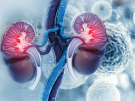Intestinal rehabilitation program demonstrates high survival rates
 In a new study, researchers at Children’s National Hospital analyzed outcomes in children with short-bowel syndrome (SBS), parenteral nutrition dependence (PND) and intestinal failure-associated liver disease (IFALD) who were treated in the Children’s National Intestinal Rehabilitation Program (IRP) from 2007 to 2018.
In a new study, researchers at Children’s National Hospital analyzed outcomes in children with short-bowel syndrome (SBS), parenteral nutrition dependence (PND) and intestinal failure-associated liver disease (IFALD) who were treated in the Children’s National Intestinal Rehabilitation Program (IRP) from 2007 to 2018.
The study, led by Clarivet Torres, M.D., director of the IRP at Children’s National, reviewed charts of 135 patients with SBS-PND at the time of their enrollment in the IRP. Of these, 89 patients had IFALD, defined as sustained (>2 months) conjugated bilirubin (CB) of ≥2 mg/dl at enrollment and/or abnormal liver biopsy, showing stage two through four fibrosis.
Historically, IFALD was a major cause of mortality among patients with intestinal failure and accounted for the high percentage of pediatric small-bowel transplants. Over the last two decades, outcomes of patients with SBS, PND and IFALD have been improving with creation of intestinal rehabilitation programs.
Recent data from the International Intestinal Failure Registry Pilot Phase showed improved outcomes, with 8% mortality. However, IFALD was the cause of death in 7% and almost 50% of patients were still PN dependent at 12 months of follow-up.
The study at Children’s National reveals normalization of the conjugate hyperbilirubinemia in 99% of the patients with IFALD, over a median time of 9.5 weeks after enrollment, with nontransplant treatment. It also demonstrates a transplant-free survival in 97% of these patients. Although the median percentage of expected bowel length in the study population was only 23% and over half had no ileocecal valve, 81% of patients were successfully weaned from PN over a median time of 5 months of being enrolled in the IRP.
Dr. Torres and her team demonstrate high rates of transplant-free survival and enteral autonomy among SBS children with IFALD who do not have underlying primary motility/genetic disorders.
Despite a high acuity of symptoms and pathology (for example, ultrashort bowel, initially high PND, initial CB >4 mg/dl, significant fibrosis/cirrhosis), they reduced their PN needs relatively quickly and improved IFALD. As one of the larger IRPs in the United States, Children’s National demonstrates high survival rates of patients without the need for liver or intestinal transplantation.
Other Children’s National authors include Vahe Badalyan, M.D., and Parvathi Mohan, M.D.
Torres C, Badalyan V, Mohan P. Twelve-year outcomes of intestinal failure associated liver disease in children with short bowel syndrome: 97% transplant -free survival and 81% enteral autonomy. Journal of Parenteral and Enteral Nutrition. 2021;1–10. https://doi.org/10.1002/jpen.2112









